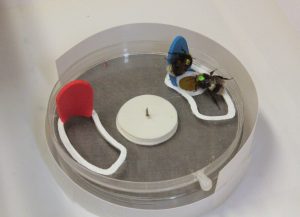“Behaviour” is the multidisciplinary and international congress of the International Council of Ethologists (ICE) that takes place every two years. Behaviour 2023 had been supported by various organisations, including the Association for the Study of Animal Behaviour (ASAB), the Ethological Society and the European Society for Evolutionary Biology (ESEB), and featured presentations covering a broad spectrum of behavioural research — from ethology to behavioural genetics to anthropology. With over 800 registered participants, more than 600 talks, over 150 poster presentations, 38 symposia and 6 workshops, Behaviour 2023 has been a platform for stimulating scientific exchange. We tried our best to make this congress an inclusive and enjoyable experience and hope that the fascinating research presented has inspired Behaviour 2023’s attendees and fostered a lot of new relationships and cooperations.
Nadine Schubert, organiser.
Alice Bridges Postdoctoral researcher at the University of Sheffield, UK.
 Can you tell us a bit about yourself and your research interests?
Can you tell us a bit about yourself and your research interests?
I’m a biologist at heart – though my PhD is technically in psychology, I studied biology for my BSc, but even before then I knew I wanted to get into research on animal behaviour. Originally I worked with corvids – rooks, jackdaws and jays – and after a brief stint as a scientific editor I managed to get a PhD position at Queen Mary University of London with Prof. Lars Chittka. This was to study bumblebee behaviour, and luckily I was given freedom by Prof. Chittka to explore whatever topic I found most interesting. Unluckily, I also found out I was deathly allergic to the bees after about six months, just as my experiments were starting to work. Under the threat of having to do computer modelling for the rest of the PhD we figured out a way to continue the experiments – mostly, lots of bee suits and students to put their hands in boxes of bees for me. They ultimately became my collaborators and co-authors, and I’m really grateful to them all for their work. We had a lot of fun, even with the looming threat of death.
I’m currently at the University of Sheffield doing a postdoc studying Drosophila, but I do at some point want to return to my bees – even if they don’t agree with me, they’re fantastic study subjects, especially for my area of interest. This would be social learning and, in particular, culture in non-human animals. Throughout my PhD, I became increasingly focused in the behaviour of invertebrates and social insects in particular: their brains are so completely alien in structure and limited in size, yet they produce some of the most fascinating behaviour in the world. It begs the question: how do they achieve that? How did they evolve to do that? I think a lot of people still think insects can’t be intelligent, or feel anything much – or worse, that they’re just revolting, scary, or nuisances. I hope that my research might change some of that, and that people will look at them again with fresh eyes.
What first interested you in this field of research?
I was first intrigued by the concept of animal culture when I first saw it described as a “second form of inheritance” – one that works alongside and complements genetic inheritance. In the simplest terms, culture refers to behaviour that is learned from others and that persists within a population over time. Being able to quickly learn new behaviour to take advantage of a new resource or alleviate a new pressure is obviously going to be really beneficial for animals, and we’re only just starting to understand the impact of culture on their life histories.
Can you briefly explain the research you presented at Behaviour 2023?
 I presented work from my PhD thesis. Some of the research was published in a paper earlier this year (“Bumblebees acquire alternative puzzle-box solutions via social learning”) and some of it was from my next manuscript, which is currently under review. Basically, we designed two different puzzle-boxes to investigate culture in bumblebees. The first was a two-action-control type design, which the bees could open to get a food reward in one of two ways. Similar designs have previously been used to investigate the capacity for culture in species such as chimpanzees, vervet monkeys and great tits. In our case, we designed a puzzle-box with a lid that could rotate either clockwise or anti clockwise if the bees pushed against either a red or blue foam tab, respectively. We trained one bee from a colony to open the box in one of these two ways, added them back to the group, and then let all the bees in to the test arena together to forage on the boxes. The naive bees, who we didn’t train, not only learned how to open the boxes, but also acquired the specific version of box-opening that their demonstrator had been taught. This persisted even when the bees discovered the alternative solution to the box – they always reverted back to their demonstrator’s technique. In essence, variations in box-opening remained within the population as a form of local behavioural ’tradition’. What was really interesting was that when we let bees explore the boxes without adding a trained demonstrator, some of them were able to learn to open the box, too – but they never got as proficient at doing this as the bees who had a demonstrator with them. These results mirrored those found in primates and birds really nicely – even though bumblebees aren’t known to show culture in the wild.
I presented work from my PhD thesis. Some of the research was published in a paper earlier this year (“Bumblebees acquire alternative puzzle-box solutions via social learning”) and some of it was from my next manuscript, which is currently under review. Basically, we designed two different puzzle-boxes to investigate culture in bumblebees. The first was a two-action-control type design, which the bees could open to get a food reward in one of two ways. Similar designs have previously been used to investigate the capacity for culture in species such as chimpanzees, vervet monkeys and great tits. In our case, we designed a puzzle-box with a lid that could rotate either clockwise or anti clockwise if the bees pushed against either a red or blue foam tab, respectively. We trained one bee from a colony to open the box in one of these two ways, added them back to the group, and then let all the bees in to the test arena together to forage on the boxes. The naive bees, who we didn’t train, not only learned how to open the boxes, but also acquired the specific version of box-opening that their demonstrator had been taught. This persisted even when the bees discovered the alternative solution to the box – they always reverted back to their demonstrator’s technique. In essence, variations in box-opening remained within the population as a form of local behavioural ’tradition’. What was really interesting was that when we let bees explore the boxes without adding a trained demonstrator, some of them were able to learn to open the box, too – but they never got as proficient at doing this as the bees who had a demonstrator with them. These results mirrored those found in primates and birds really nicely – even though bumblebees aren’t known to show culture in the wild.
The next step was to see whether bees could socially learn something from a demonstrator that was so complex that they couldn’t learn it by themselves, just through trial and error. Our second “two-step” puzzle box was designed to test this, and while I probably can’t go into too much detail as the paper is currently under review (and could only really show brief video clips at the conference) – we’re pretty sure we showed just that. The reason this is really exciting is because this would fulfil a key criteria for cumulative culture. Human culture is cumulative – we can learn things so complex that we could never innovate them individually within our own lifetime – and this capacity is still widely thought to be unique to us..
What are your next steps?
The most immediate next step is of course to get our two-step puzzle-box work published. While we can’t know for sure how long it will take (or how many journals we will have to try!) hopefully that article will be released soon. I got some really great feedback on the elements of that work that I presented from the Behaviour 2023 attendees, and I’m looking forward to hearing everyone’s thoughts about the full study.
After that, there’s a whole range of avenues that this work could go down. One of the things I really want to explore is the possibility of culture occurring naturally among social insects in the field. Stingless bees and some tropical bumblebees form colonies that last for years and span multiple biological generations, so I would love to investigate their behaviour in more detail. While the tropical bumblebees (who are notoriously large, aggressive and able to sting straight through bee suits) might be somewhat problematic, the stingless bees should hopefully be a little more tractable. I have heard that they can give you as nasty bite, though, so I suppose I will still have that to look forward to!

